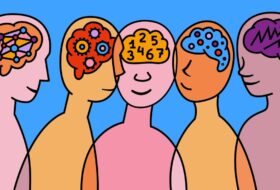
Italian researchers have found that magnetic brain stimulation can reduce or moderate cravings in those experiencing gambling and cocaine addictions. Results of the collaborative study indicate that therapeutic magnetic brain stimulation can help those with substance-related and addictive disorders beat their cravings.
Published in Frontiers of Psychology in March, the research undertaken by a team of university and public health researchers investigated the short and long-term effects of repetitive transcranial magnetic stimulation (rTMS) on craving behavior and psychopathological symptoms in people with gambling or cocaine disorders.
Promisingly, the findings suggest magnetic stimulation of the left dorsolateral prefrontal cortex (DLPFC) “produced a sustained reduction of craving intensity” for at least six months. The team also found that participants in the control or ‘dummy’ group experienced similar short-term relief, likely due to the placebo effect.
However, while those undergoing the magnetic stimulation enjoyed longer-term benefits, the effect wore off for participants receiving the “sham” treatment.
What is repetitive transcranial magnetic stimulation?
According to the Mayo Clinic, TMS is a non-invasive procedure that uses magnetic fields to stimulate nerve cells in the brain for therapeutic purposes. In most cases, clinicians deliver the treatment via successive magnetic pulses, so it’s become known as repetitive transcranial magnetic stimulation.
Typically, doctors use rTMS to treat depression when other treatments fail. However, the Federal Drug Administration has also approved it for treatment-resistant obsessive-compulsive disorder (OCD), migraines, and smoking cessation. It’s also considered a possible treatment for other disorders and conditions, including epilepsy and addictive behaviors.
As the researchers note, a “lack of clear and replicable efficacy of pharmacological and psychological treatments” means, as yet, there are no standard addiction therapies.
However, while the mechanisms that make rTMS effective are unclear, they “likely involve changes in the efficiency of cortical synapses.”
Further, because of its ability to modulate cortical excitability (aka brain activity) and its proven effectiveness for depression, rTMS is a potential therapeutic tool for the treatment of addiction.
To that end, this study aimed to test that potential.
What does an rTMS session look like?
As the Mayo Clinic outlines, during an rTMS session, an electromagnetic coil that delivers magnetic pulses is placed against the scalp to stimulate nerve cells in a particular brain region.
In this case, the focus is the left DLPFC, a key brain region involved in various cognitive functions. Specifically, it impacts functions related to executive control, working memory, attentional bias, planning, inhibition, and abstract reasoning.
While undergoing rTMS, the patient remains awake and alert during a typically painless 10-30-minute session. However, some subjects may feel tapping, hear a clicking noise, or experience mild twitching or face contortions.
Before treatment, patients must remove metal objects, like jewelry or piercings, to avoid interfering with the electromagnetic field. In most cases, patients can resume normal activities, including driving, immediately after their session.
Post-treatment, ongoing standard care—like medicine and talk therapy—may be recommended.
Importantly, medical professionals do not recommend rTMS for pregnant people or those attempting to become pregnant. Further, due to the strong magnetic field produced during rTMS, it’s not recommended for people with metal implants, devices, or certain medical conditions.
As with most medical interventions, if you suspect that rTMS might work for you or someone in your life, you must consult a doctor.
Results encouraging, but further study needed
For this study, researchers worked with 42 individuals, 19 in the real-rTMS group and 23 in the control group. Of these, 22 participants suffered from cocaine use disorder and 20 from gambling disorder.
Each participant underwent a 2-week protocol of five sessions a week of high-frequency rTMS delivered to the left DLPFC.
As previously noted, the results showed that rTMS dampened cravings for cocaine and gambling for at least six months post-treatment.
The researchers argue that this suggests magnetic therapy is a viable treatment for addictions, though more research is necessary.
This result, they said:
Supports the use of the rTMS as a treatment for general addiction and its long-term efficacy, although future studies need to assess its efficacy in other kinds of addiction and in longer time windows.
The team also found that both the treatment and placebo groups saw an initial benefit. However, after 12 weeks, the sham group’s cravings returned to pre-treatment levels. Meanwhile, the craving levels of the group receiving rTMS were “still significantly reduced after six months.”
They said this finding suggests that the initial craving reduction in the sham group could be a placebo effect.
Limitations apply
Notably, the researchers point out that their sample size was primarily men. This bias, they added, is common in addiction studies, given the higher prevalence of addiction experienced by men. However, as a result, they caution that, at this time, any conclusions should only apply to that gender.
Further, this study was limited to six months of follow-up, so conclusions are only accurate within that time range.
Subsequent studies, they argue, should consider investigating a longer time frame and the impact of follow-up treatments.
Future studies need to perform a longer monitoring of the effects and consider to add a “maintenance phase” of the protocol in which weekly or bi-weekly rTMS session are administered to the patient to “maintain” neuromodulatory effects.





